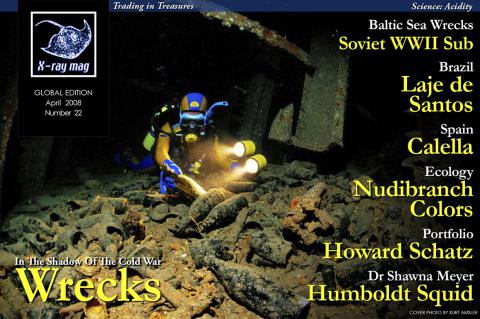Photographing Wrecks
A photographer’s heart always seems to beat a little faster when it comes to taking pictures of sunken ships and aircraft. So, how do you become successful in shooting wrecks? Granted, it is not entirely straight forward, but if you take the following advice and guidelines to heart, you will surely achieve good results.
Tags & Taxonomy
The challenge in shooting wrecks is that it often involves shooting at large distances, and that the circumstances are rarely optimal when it comes to current, visibility and depth. With the right equipment and good planning it is, however, possible to get a handle on the challenge. The objective is to portray as much of the wreck as possible, which is why the picture angle of the lens should be as large as possible. At least 90 degrees is necessary, but 180 degrees is more desirable.
The “Rolls-Royce” lenses for wreck photography are the so-called “Fisheye” lenses that are capable of capturing angles of 180 degrees or more. This, in turn, requires another piece of equipment: all wide-angle lenses must be housed behind a dome port, which is characterised by a dome-shaped spherical front glass. The curvature of this port must match the focal length of the lens if the corners of the resulting images are not to be out of focus.
Owners of SLR cameras have for a long time been spoilt for choice, with a huge selection of super wide-angle lenses with the recent addition of wide-angle lenses dedicated to digital cameras with their smaller CCD-sensors picture. When it comes to compact cameras, the possibilities are more limited, though some wide-angle lens attachments or converters have been put on the market—foremost through Sea & Sea and Inon—which enable image angles of up to 165 degrees.
The road to good wreck photography, as the ambient light always will be dominating, is to use flash to freeze the moment and bring colour to the foreground as well as enhance overall contrast in the image. That aside, you can only capture whatever reflected light the wreck is willing to give off.
There is only one way to go about it. In wreck photography, both flash automatic or TTL is taboo. Because you will usually be shooting in open water, the built-in programming will lead to wrong exposures. If the camera is equipped with a super wide-angle lens, the flash must also be capable of illuminating the same full image angle as that of the lens. Modern flash units usually cover at least 100 degrees, and that will suffice for most wide-angle lenses. If the coverage is insufficient, for example, when a fisheye lens is used, it can be necessary to use two flash units.
Most important is the correct aim of the flash or flashes. If the light has to pass through too much of the water between the camera and the object, the risk also increases that it will also bounce off suspended particles in the water and produce hazy images. It is therefore imperative to observe the following: at distances of more than 1.5 meters, the flashes must aimed straight ahead. Only if you get any nearer to the object should you consider any repositioning.
There is no flash unit in the world that can illuminate a complete wreck. That is why the exposure must always be calculated on the basis of the ambient light.
In these cases, adjust the camera’s exposure controls from readings using the built-in exposure meter in the old-fashioned manual manner. This could, for example, at a depth of 30m be aperture f:4.5 and shutter speed at 1/30 sec.
To properly balance flashlight with daylight, we know how to calculate the settings the flash unit should be set at for a given distance using f:4.5. Correctly balanced, the images will show infinite depth in the background and the foreground illuminated by just the right dose of light.
All the general rules for using flash also apply to wide-angle lenses, with the additional rule that on or inside a wreck, there is a much larger risk of stirring up particles. Good buoyancy and moving around carefully are of even greater importance to wreck photographers! The further away from the camera the flash is mounted, the less the risk is that the particles floating in front of the lens will reflect the light. ...
Download the full article ⬇︎

Originally published
X-Ray Mag #22
This issue is packed with stories on wrecks, nudibranchs, sea turtles and sharks. We visit dive destinations at Leje de Santos in Brazil and the picturesque village of Calella on the wild coast of Spain. Arnold Weisz investigates effects of the treasure trade. Learn how carbon emissions is changing the acidity of the seas and the effects on sealife. South African underwater photographer, Fiona Ayerst, reports on the tragic loss of eight Tiger sharks, three of them poached in protected waters. Andrey Bizyukin translates an interview with explorer Anatoly Sagalevich who touched bottom at the North Pole. Cedric Verdier discusses diver safety and rescue in very remote areas. Get a report on Moscow's Golden Dolphin dive show, an inside perspective of IAHD's education for disable divers, Shawna Meyer's close encounter with Humboldt squid, and tips from Kurt Amsler on shooting wrecks. We interview fine art and commercial photographer, Howard Schatz, about his latest book, H2O.


































